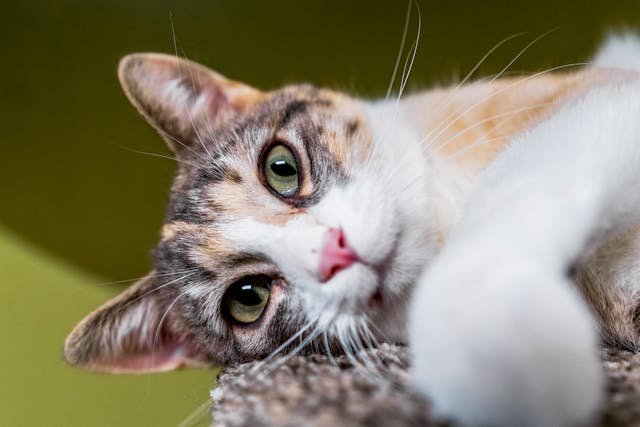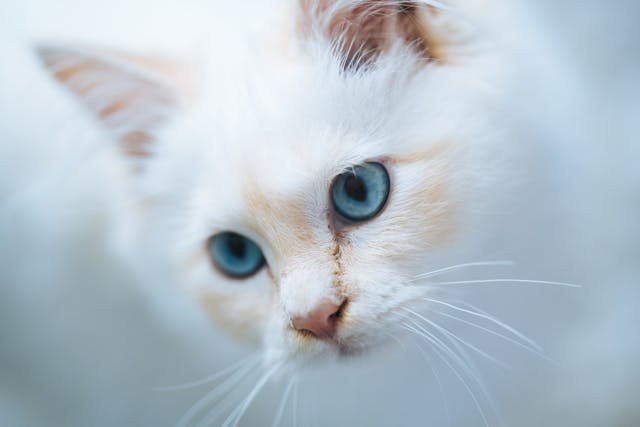Are Ragdoll cats hypoallergenic?Tips for happy Healthy Life Together…
What Does “Hypoallergenic” Mean When It Comes to Cats and Allergies?
The term “hypoallergenic” is often misunderstood when it comes to pets. Let’s break it down: Hypoallergenic does not mean that something is completely free of allergens. Instead, it means that something is less likely to trigger an allergic reaction. For cats, this term applies to breeds that produce fewer allergens compared to others.
What Causes Cat Allergies in People?
Cat allergies are caused by proteins found in a cat’s saliva, urine, and dander (tiny flakes of skin). The primary culprit is a protein called Fel d 1, which is produced in the sebaceous glands of cats. When cats groom themselves, their saliva (which contains this protein) gets deposited onto their fur. As the saliva dries, the protein turns into microscopic particles that can easily become airborne and cause allergies.
Are Some Cats Truly Hypoallergenic?
No cat breed is 100% hypoallergenic. However, some breeds are known to produce lower levels of Fel d 1, which makes them less likely to trigger allergic reactions in sensitive individuals. Breeds like the Siberian, Balinese, and Devon Rex are often touted as hypoallergenic due to their reduced production of this allergen. But where do Ragdoll cats fall on this spectrum? Are they hypoallergenic, or are they just as likely to cause allergies as other cats? Let’s find out.
Do Ragdoll cats shed less, and does that make them hypoallergenic?
Ragdolls are famous for their silky, semi-long coats, which are surprisingly low-maintenance compared to other long-haired breeds. But does this mean they shed less or produce fewer allergens?
The Truth About Ragdoll Shedding
Ragdoll cats do shed, although their shedding is often considered moderate compared to other breeds. Their fur doesn’t have an undercoat, which means they’re less prone to tangling or matting. While this may reduce the amount of fur floating around your home, it doesn’t necessarily mean they produce fewer allergens.
Shedding and Allergens: How Are They Connected?
It’s important to note that allergens like Fel d 1 are not tied to the amount of fur a cat sheds. Even if a Ragdoll sheds less than other breeds, it still produces saliva and dander that carry allergens. In short, shedding is not the determining factor when it comes to hypoallergenic qualities.
Do Ragdoll Cats Produce Less of the Fel-1 Allergen?
One of the most critical factors in determining whether a cat is hypoallergenic is the amount of Fel-1rotein it produces. So, do Ragdolls rank low on the Fel d 1 scale?
Ragdolls and Fel Levels”Are Ragdoll cats hypoallergenic?”
There’s no scientific evidence to suggest that Ragdoll cats produce significantly less Fel d 1 compared to other breeds. While individual cats may vary, Ragdolls are not specifically known for being lower in allergens. This means that if you’re highly sensitive to cat allergens, a Ragdoll may still trigger a reaction.

Why Do Some People Believe Ragdolls Are Hypoallergenic?
The misconception that Ragdolls are hypoallergenic likely stems from their laid-back grooming habits and lack of an undercoat. These traits may result in fewer loose hairs and less dander being spread around the home, which can create the illusion of being hypoallergenic. However, this doesn’t change the fact that they still produce the same allergy-causing proteins.
Tips for Reducing Allergens in a Home With a Ragdoll Cat
If you’re set on getting a Ragdoll cat but are concerned about allergies, don’t worry—there are ways to make coexisting with a cat more manageable. Here are some practical tips:
Grooming Your Ragdoll Regularly
Ragdolls require regular grooming to keep their fur in top condition. By brushing your Ragdoll a few times a week, you can:
- Remove loose fur and dander.
- Prevent allergens from spreading around your home.
- Keep your cat’s coat silky and smooth.
Creating an Allergy-Friendly Environment

- Invest in an air purifier: High-quality air purifiers with HEPA filters can help reduce allergens in the air.
- Clean frequently: vacuum carpets, furniture, and curtains regularly to remove trapped dander.
- Create cat-free zones: Designate certain areas of your home, like your bedroom, as off-limits to your Ragdoll.
Personal Hygiene and Allergy Management
- Wash your hands after handling your cat. This simple step can prevent allergens from transferring to your face or other surfaces.
- Consider allergy medications: Over-the-counter antihistamines or allergy treatments may help alleviate symptoms.
- Consult with an allergist: If you’re unsure how severe your allergies are, a specialist can provide insights and recommend solutions.
Are Ragdoll Cats a Good Choice for Allergy Sufferers?
While Ragdolls aren’t officially classified as hypoallergenic, some allergy sufferers find them more tolerable than other breeds. This could be due to their moderate shedding, lack of undercoat, or calm temperament, which may result in less allergen spread.
Ragdoll Temperament and Its Impact on Allergies
Ragdolls are known for their docile, affectionate nature. They’re less likely to engage in excessive grooming or scratching, which can reduce the amount of dander released into the air. Additionally, their calm demeanour may make it easier to manage allergens in the environment.
Should allergy sufferers avoid ragdolls together?
If you have severe allergies to cats, it’s essential to spend time around Ragdolls before committing to ownership. Everyone’s sensitivity to allergens differs, and what works for one person may not work for another.
FAQs
1. Are Ragdoll Cats Hypoallergenic?
No, Ragdoll cats are not hypoallergenic. They produce allergens like other cats, but some people may tolerate them better due to their lower shedding and lack of an undercoat.
2. Can I Reduce Allergies If I Have a Ragdoll Cat?
Yes! Regular grooming, frequent vacuuming, using HEPA filters, and washing your hands after petting your cat can help minimize allergens in your home.
3. What’s the Best Diet for a Healthy Ragdoll Cat?
A high-protein, well-balanced diet with both wet and dry food options supports their muscle growth, coat health, and overall well-being.
4. How Can I Keep My Ragdoll Cat Happy?
Ragdolls thrive on affection and companionship. Interactive toys, cozy resting spots, and daily playtime keep them engaged and content.
5. Do Ragdolls Require Special Grooming?
While their fur is long and silky, they don’t mat as easily as other long-haired breeds. Brushing them a few times a week helps keep their coat clean and reduces shedding.
Conclusion: Are Ragdoll Cats Hypoallergenic or Not?
In conclusion, Ragdoll cats are not hypoallergenic. While they may produce slightly fewer allergens due to their grooming habits and lack of an undercoat, they still produce Fel d 1—the protein responsible for cat allergies. However, with proper grooming, cleaning routines, and allergy management strategies, some allergy sufferers can enjoy life with a Ragdoll cat.
If you’re considering adopting one, take the time to evaluate your allergies and consult with a specialist if needed. Ragdols are undeniably lovable, and for many, their affectionate nature outweighs any allergy concerns. Whether you choose a Ragdoll or another breed, understanding how to manage allergens is the key to creating a happy, sneeze-free home. Here’s to finding the perfect feline companion—without the sniffles!

